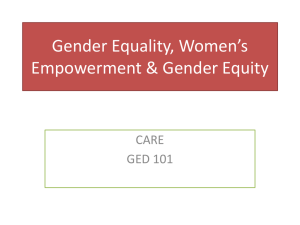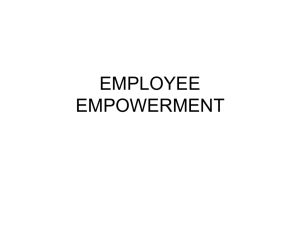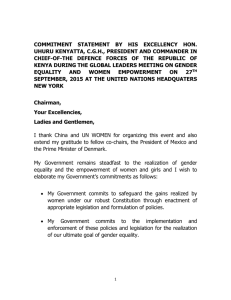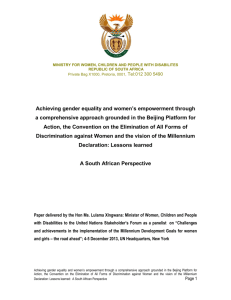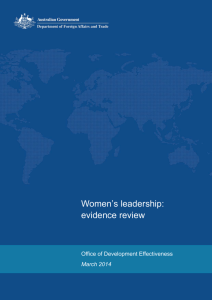4. Gender Analysis Frameworks
advertisement
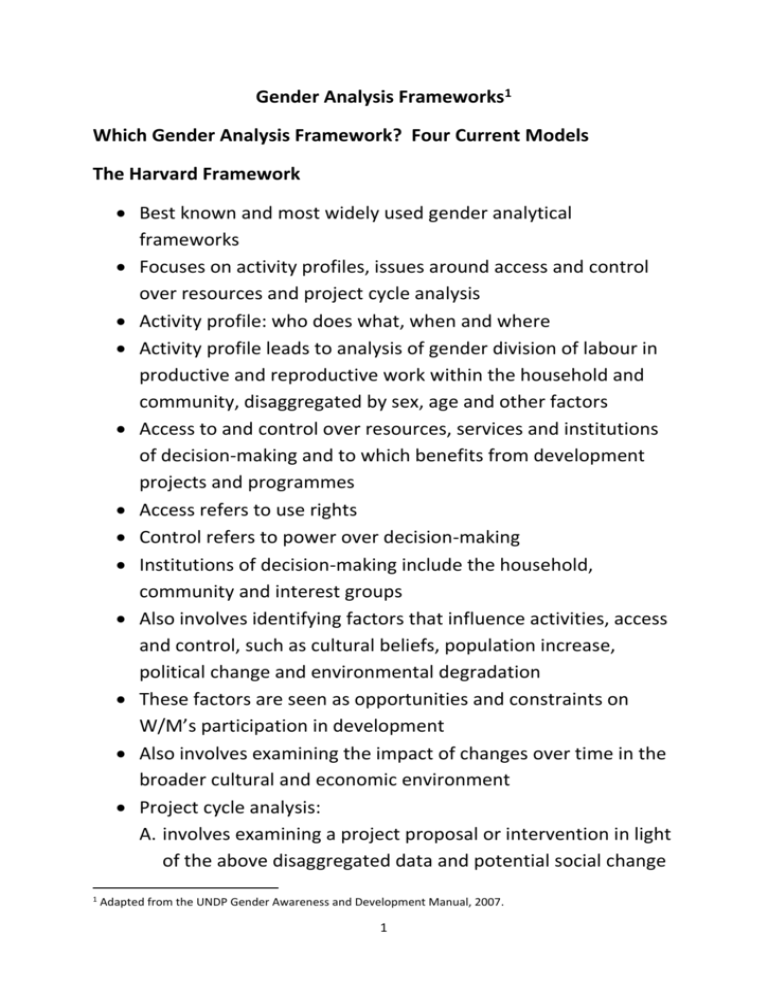
Gender Analysis Frameworks1 Which Gender Analysis Framework? Four Current Models The Harvard Framework Best known and most widely used gender analytical frameworks Focuses on activity profiles, issues around access and control over resources and project cycle analysis Activity profile: who does what, when and where Activity profile leads to analysis of gender division of labour in productive and reproductive work within the household and community, disaggregated by sex, age and other factors Access to and control over resources, services and institutions of decision-making and to which benefits from development projects and programmes Access refers to use rights Control refers to power over decision-making Institutions of decision-making include the household, community and interest groups Also involves identifying factors that influence activities, access and control, such as cultural beliefs, population increase, political change and environmental degradation These factors are seen as opportunities and constraints on W/M’s participation in development Also involves examining the impact of changes over time in the broader cultural and economic environment Project cycle analysis: A. involves examining a project proposal or intervention in light of the above disaggregated data and potential social change 1 Adapted from the UNDP Gender Awareness and Development Manual, 2007. 1 B. comprised of a series of open-ended questions relating to project identification, design, implementation and evaluation, for example: i. what needs/opportunities exist for increasing women’s productivity and/or production? ii. What needs/opportunities exist for increasing women’s access to and control over resources? The Longwe Women’s Empowerment Framework focuses first on women’s special needs, which are those needs women have due to their differential sexual and reproductive roles explores gender issues and women’s gender concerns gender gaps arise where the division of gender roles brings with it inequalities in the amount of work input, or in benefits received gender discrimination is a key concept gender gaps originate and are maintained in any society by systems of gender discrimination gender discrimination means giving differential treatment to individuals on the grounds of their gender in a patriarchal society this involves systematic and structural discrimination against women in the distribution of income, access to resources, and participation in decision-making gender discrimination is part of a patriarchal system of oppression, where males retain more power, and use this power to ensure women get most of the work and less of the benefits 2 aims to address gender gaps at all of the following levels with the aim of increasing equality between W and M and increasing women’s empowerment: Welfare: refers to the gender gap between W/M in their material well-being o A project confined to this level treats women as passive recipients of project benefits, since they are not involved in the “higher” levels of empowerment which denote more active roles in the development process o Narrowing the gender gap in welfare is the ultimate objective in women’s development, to which the process of empowerment must lead Access: refers to the means or right to obtain services, products or commodities o Gender gaps in access to resources and services are a major obstacle to women’s development. Women’s achievement of equality of access to resources and services is a key objective for women’s equality. Women’s mobilization to achieve equality of access is a key element in the process of empowerment. Conscientization: refers to the process of becoming aware of the extent to which problems arise from systematic discrimination against a social group which puts all members of the group at a disadvantage o In women’s development, this involves the process by which women collectively analyse and understand the gender discrimination they face. This is the basis for action to overcome obstacles which have been holding them back. Participation: denotes having a share in decision-making 3 o Gender equality in decision-making is an essential aspect of women’s empowerment o Participation is concerned with collective participation in decision-making, which is a process integrated with conscientization Control: means the ability to direct, or to influence events so that one’s own interests are protected o This is the “highest” aspect of women’s developmentwhere women ensure that resources and benefits are distributed so that W and M get equal shares Institute of Development Studies (IDS) Social Relations Framework Looks at social relations; institutions; dimensions of social relationships; interventions; and needs, interests and empowerment Social relations: defined as the way people are positioned in relation to resources and power o Include not only gender relations but also relations of class, ethnicity, nationality and religion o Vary across cultures o Refers also to resources and networks of groups and individuals Institutions comprise four categories: o State: legal, military and administrative organizations o Market: firms, corporations and farming enterprises o Community: village committees, patron-client relationships o Household Dimensions of social relationships comprise: Rules: official and unofficial rules, values, traditions, laws and customs 4 People: who is in and who is out Resources: what is used and what is produced Activities: what is done and who does what Power: who decides and whose interests are served At level of interventions, gender neutral policies are policies which intend to leave the gender division of labour and the gender division of resources intact but attempt to target the appropriate actors to achieve certain goals o Gender-specific policies look at the existing distribution of labour and resources but intend to achieve a goal which will entail targeting one gender or the other o Gender-redistributive policies are about change and transformation, interventions designed to transform existing asymmetries and inequalities Needs: distinguishes between practical gender needs and strategic gender interests The Development Planning Unit (DPU) Framework Is a gender policy and planning framework which aims to integrate a gender perspective into development practice Gender relations understood as interwoven with other power relations like class, ethnicity, religion and age in different contexts Proposes a gender policy and planning process which is iterative versus linear Begins with gender diagnosis, utilizing a tool called ‘web of institutionalization’ to assess how a gender perspective is currently institutionalized in context under consideration Identifies at least 13 elements which are crucial to the process of institutionalization 5 The elements are women’s and men’s experience and their interpretation of reality, pressure of political constituencies, representative political structures, political commitment, policy, resources, mainstream responsibility for gender issues, procedures, methodology, research and theorybuilding. The diagnosis on each element and their interrelation is done, considering: o Gender roles: reproductive, productive, community managing and consistency-based politics role o Access to and control of resources o Gender needs: practical and strategic gender needs o Underlying policy approaches implied in or impacted on each element The diagnosis of each element and their interrelation generates problems (i.e. weak or no gender integration) and potentials (i.e. opportunities which might offer an opening for gender integration) Final step in diagnosis is to prioritize the problems and potentials in order to clarify entry points for action Gender diagnosis is a continuous process and constantly interacts with another component of the gender policy and planning process, called gender consultation Gender consultation refers to dialogue with W/M in communities to define their own gender needs, as well as with W/M involved in the particular organization acting in the context under consideration 6



